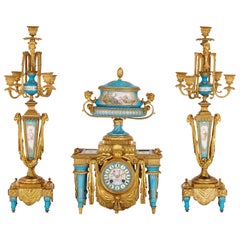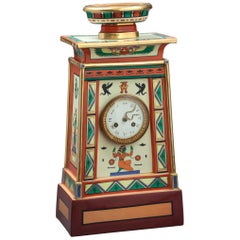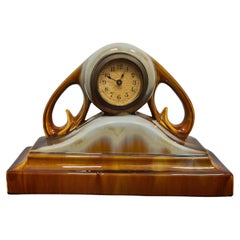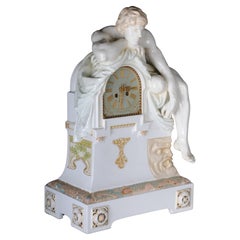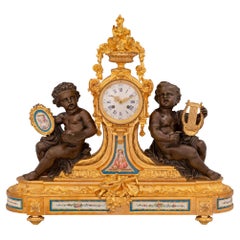Ceramic Clocks
to
64
509
12
14
391
104
12
35
39
22
10
1
2
3
3
12
11
10
2
98
34
32
31
20
18
9
8
7
4
3
2
2
2
1
1
1
1
95,093
4,098
1,605
1,587
1,064
291
208
478
352
51
21
21
Height
to
Width
to
521
509
513
12
11
10
9
8
Material: Ceramic
Gilt Bronze and Sèvres Style Porcelain Clock Garniture
Located in London, GB
Gilt bronze and Sèvres style porcelain clock garniture
French, 19th century
Measures: Clock height 46cm, width 29cm, depth 24c...
Category
19th Century French Louis XVI Antique Ceramic Clocks
Materials
Ormolu, Bronze
Paris Porcelain Egyptian Style Clock, Bayeaux, circa 1830
Located in New York, NY
Paris Porcelain Egyptian Style clock, Bayeaux, circa 1830.
Category
1830s French Antique Ceramic Clocks
Materials
Porcelain
Ceramic clock from the 1940s'
Located in Torino, IT
Ceramic clock from the 1940s.
Fine centerpiece or mantel clock made in the 1940s.
The structure is completely made of glazed ceramic with shades ranging from brown to light blue.
...
Category
1940s Italian Vintage Ceramic Clocks
Materials
Ceramic
$373 Sale Price
20% Off
Monumental Art Nouveau mantel clock with enamel and soft painting. 62 cm
Located in Berlin, DE
Monumental, impressive Art Nouveau mantel clock with enamel and soft painting. 60cm
KPM Berlin probably around 1904. Designer: Hugo Cauer. Body...
Category
Early 1900s German Antique Ceramic Clocks
Materials
Brass, Enamel
19th Century French Sevres Style Figural Garniture Clock Set
Located in Tarzana, CA
This excuisite 3-piece 19th century French ormolu mounted porcelain clock set comprising a central clock and a pair of flanking candelabra. The clock in urn shape form over a gilt br...
Category
19th Century French Antique Ceramic Clocks
Materials
Ormolu
French 19th Century Louis XVI Style Sèvres Porcelain and Ormolu Clock
Located in West Palm Beach, FL
A magnificent French 19th century Louis XVI st. Sèvres porcelain and ormolu clock. The clock is raised by fine topie shaped feet below the ormolu base which is decorated with elegant...
Category
19th Century French Louis XVI Antique Ceramic Clocks
Materials
Bronze, Ormolu
19th Century Sevres Clock Set
Located in Brighton, Sussex
A fine quality 19th century French Sevres porcelain and gilded ormolu clock garniture. Having a very impressive pair of five branch candelabra each...
Category
1890s French Antique Ceramic Clocks
Materials
Ormolu
$75,549 / set
Rare Louis XVI Period with Marble Mantel Clock
Located in Montreal, QC
Rare Louis XVI period white marble mantel clock extensively decorated with very fine gilt bronze mounts, the white enamel dial flanked by two neoclassical urns, extensively decorated...
Category
18th Century and Earlier European Louis XVI Antique Ceramic Clocks
Materials
Marble, Bronze
19th Century Sevres Style Gilded Ormolu Mantel Clock
Located in Brighton, Sussex
A wonderful French 19th century gilded ormolu mantel clock, having a putti mounted to the top holding garlands of flowers, draping down the case, Rams heads and urns of flowers. The ...
Category
Late 19th Century French Louis XVI Antique Ceramic Clocks
Materials
Ormolu
19th Century French Gilt Bronze and Porcelain Clock in the Louis XVI Taste
Located in London, GB
A mantle clock in the Louis XVI taste by Raingo Freres, Paris
Constructed in gilt bronze, and dressed with Bleu Celeste framed porcelain panels, decorated in polychromes, in the '...
Category
Late 19th Century French Louis XVI Antique Ceramic Clocks
Materials
Ormolu, Bronze
French 19th Century Louis XVI Style Mantel Clock Signed by J Marti
Located in Los Angeles, CA
French 19th century Louis XVI style mantel clock signed by J Marti. Made from marble and gilt bronze with porcelain dial.
Category
Mid-19th Century French Louis XVI Antique Ceramic Clocks
Materials
Marble, Bronze
French Sevres style clock set, C19th
Located in Brighton, Sussex
A very good quality French 19th Century Louis XVI Sevres style clock garniture. Having reclining maidens with garlands of flowers supporting an urn ...
Category
19th Century French Antique Ceramic Clocks
Materials
Ormolu
Napoleon III, Gilt Bronze and Porcelain Mantel Clock, 19th Century
Located in Beaune, FR
Imposing and magnificent fireplace gilded bronze and blue porcelain vases. The clock is decorated with putti representing the 4 seasons. It is su...
Category
19th Century French Napoleon III Antique Ceramic Clocks
Materials
Bronze
19th Century French Pink Porcelain Clock with Cupid & Romantic Emblems
By Japy Frères
Located in London, GB
A Symbolic clock in the Louis XVI style
By Japy Fréres et Cie.
The finely chased ormolu case encompassing pink porcelain panels decorated with beads to the face and sides; the wh...
Category
Late 19th Century French Louis XVI Antique Ceramic Clocks
Materials
Ormolu, Bronze
French Porcelain Mantel Clock
Located in Norwich, GB
French Porcelain mantel clock standing on a raised plinth and resting on
Beautifully decorated break arch case with Fleur de lys on a midnight blue groun...
Category
1880s French Victorian Antique Ceramic Clocks
Materials
Porcelain
French Porcelain and Bisque Mantel Clock by Miroy Freres, Paris
By Miroy Frères
Located in Norwich, GB
French Porcelain and Bisque pottery mantel clock with floral decoration and gilded garlands supporting a French Nobleman and his mistress. Beautifully decorated with an enamel dial and Roman numerals to the French eight day movement with outside countwheel strike signed ‘Miroy Freres...
Category
1850s French Napoleon III Antique Ceramic Clocks
Materials
Porcelain
French Napoleon III blue porcelain and ormolu clock
Located in London, GB
A very fine & attractive French porcelain & gilt bronze mantle clock. A superb dial & very finely painted urn surmounting the clock. To each side of the dial further painted panels. ...
Category
1880s French Antique Ceramic Clocks
Materials
Bronze
French Sevres style porcelain vase / mantel clock.
Located in Brighton, Sussex
A very good quality late 19th Century French Sevres style porcelain lidded vase / clock. Having wonderful gilded ormolu mounts, a cherub finial and monopodia handles, an enamel faced...
Category
Late 19th Century French Antique Ceramic Clocks
Materials
Porcelain
19th Century Pink 'Sevres' Porcelain Mantel Clock
Located in Brighton, Sussex
A very pretty 19th century French pink 'Sevres' porcelain and gilded ormolu mantel clock. Having classical foliate and swag decoration surrounding the pink porcelain plaques which de...
Category
19th Century French Antique Ceramic Clocks
Materials
Ormolu
19th Century French Louis XVI Clock Garniture with Sévres Porcelain and Ormolu
By Arnold & Lewis 1
Located in London, GB
A Garniture de Chemineé in the Louis XVI taste
By Arnold & Lewis (late Simmons)
The mantle clock, and its two matched vases, are constructed in jewelled 'Sèvres' style porcelain, hand and polychrome decorated, with gilt highlights and finely gilt bronze. The clock, rising from toupie feet, supports a rectangular base frame with rounded ends, set with cast stiff leaf decoration, and having inset Roi de Bleu and gilt work panels; over, the circular porcelain dial, signed by the maker (qv) has Roman numerals and blued steel hands, and is set over a central porcelain panel with a bucolic scene, and flanked by elliptical female portraits; the ends are curved and conformingly polychrome and gilt decorated; the whole is surmounted by a decorated twin handled urn, having a pine cone finial, set on an addorsed acanthi gilt bronze base. The two train clock...
Category
Late 19th Century French Louis XVI Antique Ceramic Clocks
Materials
Bronze
Antique French Japonisme Silvered Bronze and Porcelain Three-Piece Clock Set
Located in London, GB
Antique French Japonisme silvered bronze and porcelain three-piece clock set
French, Late 19th Century
Clock: Height 36cm, width 32cm, depth 17cm
Candelabra: Height 28cm, width 26...
Category
Late 19th Century French Japonisme Antique Ceramic Clocks
Materials
Bronze
French 19th Century Louis XVI St. Sévres Porcelain And Ormolu Annular Clock
Located in West Palm Beach, FL
A sensational and high quality French 19th century Louis XVI st. Sévres porcelain and Ormolu annular clock. The clock is raised by a square Ormolu base with a Coeur de Rai border des...
Category
19th Century French Louis XVI Antique Ceramic Clocks
Materials
Ormolu
Belle Époque Period Ormolu and Porcelain Mantel Clock in Moorish Style
Located in London, GB
This beautiful clock, formed from gilt bronze and porcelain, is designed and decorated in a discernibly Moorish style. The clock is supported by a flat shaped gilt bronze base, the base supporting four gilt bronze columns that support the gilt bronze clock drum. The cylindrical drum contains a circular dial, the dial of porcelain and inscribed with Roman numerals.
The gilt bronze throughout is cast and chased with geometrical motifs—particularly evident on the front of the four vertical columns. These motifs are distinctively Moorish in scheme, the lattice-type geometrical sequences recalling Islamic decorative...
Category
Late 19th Century French Moorish Antique Ceramic Clocks
Materials
Ormolu, Bronze
Late 19th Century, Vienna Porcelain Mantel Clock
Located in Brighton, Sussex
A good quality late 19th century Vienna porcelain mantel clock, having hand-painted classical figures and cherubs.
Category
Late 19th Century Austrian Antique Ceramic Clocks
Materials
Porcelain
French 19th Century Louis XVI St. Cobalt Blue Porcelain and Ormolu Clock
Located in West Palm Beach, FL
A striking and most elegant French 19th century Louis XVI st. cobalt blue porcelain and ormolu clock. The clock is raised by a square ormolu base with cut corners with fine rosettes ...
Category
19th Century French Louis XVI Antique Ceramic Clocks
Materials
Ormolu
Antique Three-Piece Meiji Period Japonisme Vase Clock Set
Located in London, GB
Antique three-piece Meiji period Japonisme vase clock set
French/Japanese, late 19th century
Measures: Clock height 47cm, diameter 22cm
Candelabra height 55cm, width 25cm, depth 2...
Category
Late 19th Century French Japonisme Antique Ceramic Clocks
Materials
Ormolu
Antique French Sevres Mantel Clock
Located in Brighton, Sussex
A very good quality French 19th century gilded ormolu and pink Sevres porcelain mantel clock. Having monopodia supports, a putti supporti...
Category
19th Century French Louis XVI Antique Ceramic Clocks
Materials
Ormolu
Rococo Style Gilt Bronze Mounted Porcelain Clock Garniture
Located in London, GB
Rococo style gilt bronze mounted porcelain clock garniture
French, late 19th century
Measures: Clock: Height 38cm, width 27cm, depth 13...
Category
Late 19th Century French Rococo Antique Ceramic Clocks
Materials
Ormolu, Bronze
Large 19th Century French Mantel Clock
Located in Brighton, Sussex
A very impressive 19th century French gilded ormolu and Severs porcelain mantel clock. Having putti on either side, holding garlands of flowers. Inset hand-painted Sevres porcelain p...
Category
19th Century French Louis XVI Antique Ceramic Clocks
Materials
Ormolu
Three-piece French porcelain and gilt bronze clock set
Located in London, GB
Three-piece French porcelain and gilt bronze clock set
French, late 19th Century
Clock: Height 27cm, width 36.5cm, depth 12cm
Candelabra: Height 33cm, width 20cm, depth 11.5cm
This fine three-piece clock set is by Henri Picard, one of the leading producers of luxury bronze...
Category
19th Century French Neoclassical Antique Ceramic Clocks
Materials
Ormolu
Fine 19th Century Sevres Style Mantel Clock
Located in Brighton, Sussex
A fine quality late 19th Century French Sevres style mantel clock, having a wonderful gilded ormolu case with an urn to the top with cobalt...
Category
19th Century French Louis XVI Antique Ceramic Clocks
Materials
Ormolu
Porcelain Mounted Ormolu Antique French Three Piece Clock Set
Located in London, GB
Of porcelain mounted ormolu, the clock's dial marked 'Raingo Fres, Paris', the central clock decorated with a scene of traditional 19th century courtship, the two flanking candelabra...
Category
19th Century French Antique Ceramic Clocks
Materials
Bronze
Antique French Clock with Porcelain Face
By Japy Frères
Located in Asheville, NC
Handsome antique clock has Roman numerals and marked minutes with detailed hands on porcelain face. Glass-encasement is made of brass and bevelled cover...
Category
19th Century French Antique Ceramic Clocks
Materials
Marble, Slate, Iron
Antique Gilt Bronze and Porcelain Mantel Clock with Chivalric Scenes
Located in London, GB
This beautiful porcelain mantel clock is designed in the shape of a shield which is propped up on a gilt bronze (ormolu) easel support, composed of two shields and a staff topped by ...
Category
Late 19th Century French Gothic Antique Ceramic Clocks
Materials
Ormolu, Bronze
19th Century French Gilt Bronze and White Porcelain Three-Piece Garniture Set
Located in Tarzana, CA
A 19th century French gilt bronze, enamel and porcelain three-piece garniture set.
Beautifully shaped with two putties playing the flute under a hand-painted white ground porcelai...
Category
Late 19th Century French Rococo Antique Ceramic Clocks
Materials
Bronze
French Neoclassical Style Sevres Bisque Clock Signed Guyon a Lyon
Located in West Palm Beach, FL
An elegant French neo-classical st. Sèvres Bisque clock signed Guyon a Lyon ( Jean Baptiste Guyon). The clock is raised by ormolu supports below th...
Category
19th Century French Antique Ceramic Clocks
Materials
Ormolu
French 19th Century Neo-Classical Style Porcelain and Ormolu Clock
Located in West Palm Beach, FL
A most attractive French 19th century neo-classical st. porcelain and ormolu clock. The clock is raised by fine scrolled ormolu feet below the beautiful deep forest green porcelain b...
Category
19th Century French Neoclassical Antique Ceramic Clocks
Materials
Ormolu
Late 19th Century Gilt Bronze Mounted Parcel-Gilt and Biscuit Porcelain Clock
Located in Long Island City, NY
A beautifully design late 19th century gilt bronze mounted parcel-gilt and biscuit porcelain mantel (fireplace) clock
The front carved with Apollo riding his chariot. The bottom wit...
Category
Late 19th Century French Belle Époque Antique Ceramic Clocks
Materials
Bronze, Ormolu
Fine Napoléon III Gilt-Bronze Mounted Porcelain Clock Garniture, circa 1870
Located in Brighton, West Sussex
A fine Napoléon III gilt-bronze mounted porcelain clock garniture.
French, circa 1870.
The movement stamped with the 'Japy Frères ' cachet.
This fine porcelain clock set is...
Category
Late 19th Century French Napoleon III Antique Ceramic Clocks
Materials
Bronze
Victorian Antique Porcelain Mantel Clock by Benjamin Lewis Vulliamy, London
By Benjamin Lewis Vulliamy
Located in Devon, GB
A fine early 19th century Coalport Porcelain cased timepiece by this famous maker.
The elaborate pink ground porcelain case is set with exotic birds and flowers on scroll feet, wi...
Category
19th Century English William IV Antique Ceramic Clocks
Materials
Porcelain
Antique Continental Gilt Bronze, Cut Glass, and Porcelain Clock Set
Located in London, GB
Antique Continental gilt bronze, cut glass, and porcelain clock set
Continental, late 19th century
Clock: Height 45cm, width 30cm, depth 22cm
Candelabra: Height 46cm, width 23cm, ...
Category
Late 19th Century European Antique Ceramic Clocks
Materials
Ormolu
Still Thinking About These?
All Recently ViewedMore Ways To Browse
Clocks With Birds
Deniere A Paris
English Regency Clocks
Green Marble Clock
Library Clock
Louis Xv Boulle Clock
Pink Mantel Clock
Polychrome Clock
Portico Marble Clock
Psyche Clock
Regency Bracket Clock
Antique Calendar Clocks
Antique Guilloche Miniature Clock
Art Nouveau Bronze Clock
Clock Horse
French Art Deco Mantle Clock
George Iii Long Case Clock
Inlaid Grandfather Clock
